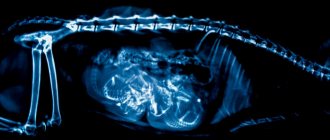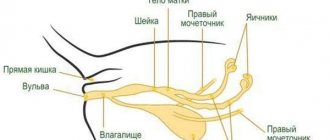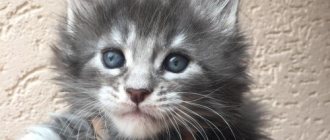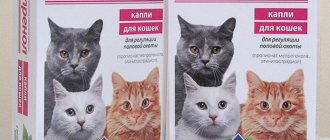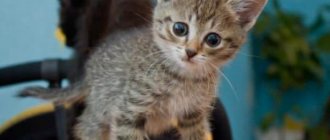False pregnancy in cats is considered a rare pathology. The condition most often develops against the background of hormonal disorders and is accompanied by nipple enlargement, increased drowsiness, moderate hyperthermia, and non-pathological discharge from the mammary glands and vagina. The disease is dangerous due to complications such as mastitis, oncology, and pyometra. At the first symptoms, the owner should take the cat to the veterinarian, who will prescribe treatment and give preventive recommendations.
According to veterinarian statistics, 50% of cancerous tumors are diagnosed on the mammary glands of a cat, the cause of which is an imaginary pregnancy.
False pregnancy in cats: what is it?
This is the name of a pathological (in the case of cats, truly pathological, more on that below) condition in which the animal not only looks like it is pregnant, but also “considers” itself to be so. There is no real pregnancy, as is easy to understand.
And I would like to immediately clarify one important nuance. Experienced “cat lovers” often claim that false pregnancies do not occur in cats at all. In part, they actually have reasons for such categorical statements: when compared with dogs, the frequency of imaginary pregnancies in cats is negligible. But if you look at the general statistics specifically for cats, everything becomes not so rosy. Although rare, there are also cases of “idle” in cats.
In dogs, this condition is natural, developed during centuries of evolution. Due to this, a pack of wolves can easily feed a dozen or two wolf cubs whose mothers died hunting: “false” females will feed them. Even if their pregnancy is not real, the milk they produce is the most natural!
But in cats, imaginary pregnancies are a very bad sign. For these animals they are unnatural and often indicate dangerous pathologies of the reproductive system.
In addition, in nature, cats are not known to be excessively “altruistic”: females not only do not accept or feed other people’s kittens, but even kill them (though not always, but very often).
Possible complications
The risk of dangerous consequences for the body after pseudo-pregnancy is very high. This phenomenon is fraught with the following ailments:
- inflammation of the uterus . The reason for the phenomenon is the body’s preparation for motherhood in the absence of a fetus. The disease is fraught with the formation of tumors;
- hormonal disorders . Because of them, thyroid diseases and disorders of various body functions occur;
- mastitis . The milk that appears in the female’s glands does not leave, since there are no offspring. Its stagnation provokes the development of the disease. How to help a cat at home with this disease (in addition to drug treatment) can be read below.
Helping a cat with mastitis
Important! False pregnancy often causes the development of serious mental disorders in an animal. If you do not provide assistance to the animal in a timely manner, it can become dangerous to people and damage various surfaces in the home.
Video - Pyometra in animals
This is interesting: Why cats give birth to dead kittens
Causes of false pregnancy in cats
Let's consider the main reasons for the development of pathology. What happens most often is this:
- It happens that a false pregnancy is the result of a “spree” with a recently castrated male (or a cat whose sterility is a consequence of other reasons). Those. in such a situation, there was sexual intercourse, mechanical stimulation of the external genitalia occurred, the ovaries “spit out” the egg... but in fact there were no sperm capable of fertilizing it. In this case, the female’s body can become “confused,” up to the development of a full-fledged corpus luteum, the beginning of prolactin synthesis, etc.
- However, castrati rarely retain the ability to copulate, and sterile cats “in the wild” are not very common. It is much more likely that the cat herself has problems with the reproductive system. Those. and there was sexual intercourse, and the release of the egg occurred, but... For some reason, further development of the gamete is inhibited or even stops, but the body already “gets a taste” and “feels” itself pregnant.
- In very rare cases, severe and prolonged stress may be to blame. For example, moving, long and unsuccessful renovations in an apartment, etc.
Why is pathology dangerous?
So why is imaginary pregnancy dangerous in cats? To many:
- Since these pets often develop it for a reason, but against the background of quite serious hormonal disorders or pathologies of the reproductive system, with special “luck” it can lead to oncology.
- It has been noticed that cats that have had an “empty” pregnancy two or more times in a row are subsequently practically useless from the point of view of reproduction. They either become worse pregnant, or their offspring are weak and nonviable.
- The likelihood of pyometra, chronic endometritis and ovarianitis (inflammation of the uterus and ovaries, respectively) increases.
Mastitis during false pregnancy
But still, more often than not, cat owners face another problem. Mastitis during false pregnancy occurs very often. The problem is that cats themselves are extremely difficult to tolerate inflammation of the mammary glands; the risk of death is quite high.
The mechanism of mastitis development in this case is very simple:
- Since during a false pregnancy milk secretion occurs regularly, but there is no one to suck it out, the liquid constantly accumulates in the alveoli and milk ducts.
- Gradually, the pressure becomes such that the milk flows by gravity (sometimes with force, as if from a spray bottle) out of the nipples.
- If these streaks are not removed in time and the skin is not wiped, the milk turns sour, creating excellent conditions for the development of pathogenic and conditionally pathogenic microflora. Gradually, the microbes will penetrate into the mammary gland itself and cause inflammation there.
With this pathology, the nipples and adjacent tissues become very hard, and local and general body temperature rises. The slightest touch to the nipples results in inappropriate behavior of the animal, to which palpation causes unbearable pain.
Important! Treatment in a clinical setting is urgently required, as otherwise the cat could easily die.
In particular, with the slightest delay, inflammation easily turns into a purulent form, when thick, yellow-green pus begins to secrete from the nipples. The probability of successful treatment is 50/50 (in other words, depending on your luck). In addition, in advanced cases, sterilization is almost always required.
Sterilization and its connection with false pregnancy
Sterilization, that is, removal of the uterus and ovaries, is a radical way to combat false pregnancy. The necessary hormones are not produced, and the condition becomes impossible, so frequently recurring similar hormonal disorders are a clear indication for sterilization. If the individual is a breeder, it is not at all necessary to sterilize it after the first unsuccessful mating; first you need to try to find out the cause of the problem. Perhaps, after a change of partner or after treatment, the pet will be able to have offspring, and the disease will not recur.
Surgery is recommended if the owner does not intend to breed the pet - after sterilization, the pet will be free from diseases of the reproductive system in the future, and, perhaps, will live several more years of life.
How to distinguish a false pregnancy from a real one
So how to distinguish a false pregnancy from a real one based on a set of mental signs? In general, this is not so easy to do; you need to pay attention to many small nuances:
- A “false-positive” cat’s mood changes very often and completely unpredictably. At one moment she can be active and playful, and after a few minutes she begins to hiss and avoid people.
- Some cats become overly affectionate, while others hiss and run away from their owner, even if they previously could not live without his constant attention.
- If during a normal pregnancy the animal begins to look for a place to give birth a couple of days (a week) before the birth, then during a false pregnancy it does this constantly, which drives the owners into hysterics. A cat can rummage through closets all day long and for at least three weeks, “inspecting” the most remote corners of the house.
- Again, “preliminary” postpartum behavior is extremely uncharacteristic of a normal pregnancy. But with pathology, a cat that does not have and never had kittens begins to carry socks, slippers, small boxes and other “garbage” in its teeth, which it perceives as kittens.
It happens that during a false pregnancy, a cat becomes incredibly noisy: she constantly yells, demanding attention, meows and “squeaks.” Sometimes animals seem to “go crazy”, they become violent and completely uncontrollable. This happens due to an abnormal surge of hormones, as well as when hormones appear in the bloodstream, the combination of which is normal or does not exist at all, or their concentration is much lower.
Discharge and other physiological signs of pathology
These signs are no longer subjective and are clearly visible to the naked eye:
- There is mucous discharge from the vulva. And if during a normal pregnancy they are rare and not too regular, then during a false pregnancy, mucous discharge from the external genitalia is constantly observed.
- The abdomen enlarges and sags. Again, with normal gestation of kittens, this sign does not develop immediately, while with a false pregnancy, the cat may already look as if it is about to give birth in the second week.
- The cat's appetite first increases and then worsens. In a normal pregnancy, the opposite is true: in the first half of gestation, the cat eats worse, but then the appetite quickly increases.
- A riot of hormones often leads to frequent gastrointestinal disorders.
- In addition, this pathology is quite characterized by a chronic increase in general body temperature.
What do the mammary glands look like during a false pregnancy?
Note that the mammary glands of a “false-positive” pet look exactly the same as if she were actually pregnant:
- The nipples become noticeably enlarged and swollen.
- As we mentioned above, milk production begins.
We also note that not all cases develop all of the above symptoms. Their appearance/non-appearance depends both on the specific case of pathology and on the psychophysical state of the cat. In addition, some pets have an extremely difficult time experiencing the state of an imaginary pregnancy, sometimes it even comes to real mental “oddities”.
Other cats may perceive their condition as a minor inconvenience. Accordingly, in the latter case, the likelihood of severe consequences is much lower, and there are much fewer reasons to visit the veterinarian.
Female reproductive cycle
The female reproductive cycle consists of four periods:
- Proestrum is the initial period of estrus. Duration: one to two weeks. Manifested by the presence of bloody discharge from the vagina, hyperemia of the vulva. At this time, follicles mature in the ovaries, releasing the hormones estrone and estradiol into the blood. Under the influence of estrogens, hyperplasia of the uterine tissue begins, preparing them for implantation of embryos.
- Estrus is hunting. Duration: one to two weeks. Characterized by strong sexual arousal of the female. The discharge brightens, becomes mucous, ovulation occurs - the opening of mature follicles and the release of eggs (oocytes).
- Metoestrum is the end of estrus. Duration: one to two months. Sexual arousal disappears, the loop decreases to normal size. The follicles, under the influence of gonadotropin, turn into corpus luteum, producing progesterone. Unfertilized eggs are destroyed, fertilized eggs develop - pregnancy begins.
- Anestrum is a period of rest. Duration: three to four months. In the absence of fertilization, the corpus luteum atrophies, progesterone production decreases, and follicle maturation resumes.
What to do and how to calm a cat at home?
Firstly, you need to figure out when you need to take some steps, and when the animal’s body can overcome the attack on its own. So, you need to do something yourself or immediately contact a veterinarian in the following cases:
- False pregnancy lasts more than three weeks and there are no visible signs of normalization of the animal’s condition.
- The cat becomes extremely nervous or so apathetic that it resembles an amoeba.
- It is necessary to immediately take your pet to the clinic if there is a suspicion of mastitis (and even more so if there are pronounced clinical signs of inflammation).
If you don’t have all this, here’s what to do and how to calm your cat at home:
- It is necessary to reduce the animal's consumption of any liquid by approximately 1/3, including moisture from canned or natural food. This is the most important condition!
- For the same reasons, we recommend increasing the total proportion of dry food in your pet’s diet.
- It is necessary to protect the cat from contact with its relatives.
- It is also necessary to play with your pet and communicate with it more often. The more often the owner does this, the less time the animal will have to select a place “for birth”, the faster it will calm down and return to normal.
- You should not be nervous and scold the cat, as this will only make everything worse.
Drugs for treatment in clinical settings
Please note that medications to eliminate the manifestations of false pregnancy in cats can and should only be prescribed by a veterinarian! Many of these medications can kill a cat if used incorrectly.
At the clinic, doctors use sedatives (at least simple Diphenhydramine) to calm the animal. To stop milk production, hormonal prolactin antagonists are used. To treat mastitis, it is often necessary to resort to anti-inflammatory corticosteroids in combination with broad-spectrum antibiotics and other antimicrobial drugs.
Remember! Hormonal therapy is resorted to only in the most difficult cases, since in such situations the animal’s condition can easily be aggravated.
And even more so, we do not advise owners to buy and prescribe these medications to their cats on their own: the risk of permanently undermining the cat’s health is maximum, but there is almost no chance of curing the pet on their own.
Medication assistance
Not only psychological problems, but also physiological disorders in the body can cause false pregnancy in a cat. Treatment in this case will require the use of medications. All of them should be prescribed only by a veterinarian after examining the animal. Sedatives are usually used to stop lactation. Adjusting your cat's diet to reduce the amount of dairy products and carbon-containing ones will help reduce milk production. A prolonged lactation process can lead to mastitis and other problems. Therefore, it is recommended to take all possible measures - massage the mammary glands, cool compresses, apply compression bandages. If mastitis does start, you cannot do without antibiotics.
Doctors often recommend the drugs Naloxone or Cyclozocine. Their dosage must be calculated individually for each animal and applied no more than twice a day. Medicines have a large number of side effects and contraindications. Naloxone can cause nausea and vomiting, so before taking it, it is advisable to give the cat an antiemetic, for example, Cerucal or Metocloramide.
Prevention of false pregnancy in cats
In general, imaginary pregnancy in cats is a relatively infrequent phenomenon, and therefore there are simply no studies studying the prevention of pathology. In fact, the only prevention that works 100% is sterilizing the cat. Moreover, to prevent estrus and “pregnancy,” it is imperative to remove not only the uterus, but also the ovaries. In addition, it is necessary to treat all hormonal pathologies in a timely manner by contacting a veterinarian. All oddities in the cat’s behavior should also not go unnoticed by the owner: if something worries him, it is better to immediately take his pet for a preventive examination to a specialist.



